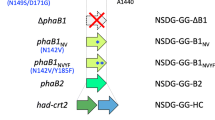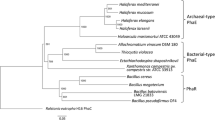Abstract
A polyhydroxyalkanoate (PHA) synthase gene phaC2 Ps from Pseudomonas stutzeri strain 1317 was introduced into a PHA synthase gene phbC Re negative mutant, Ralstonia eutropha PHB−4. It conferred on the host strain the ability to synthesize PHA, the monomer compositions of which varied widely when grown on different carbon sources. During cultivation on gluconate, the presence of phaC2 Ps in R. eutropha PHB−4 led to the accumulation of polyhydroxybutyrate (PHB) homopolymer in an amount of 40.9 wt% in dry cells. With fatty acids, the recombinant successfully produced PHA copolyesters containing both short-chain-length and medium-chain-length 3-hydroxyalkanoate (3HA) of 4–12 carbon atoms in length. When cultivated on a mixture of gluconate and fatty acid, the monomer composition of accumulated PHA was greatly affected and the monomer content was easily regulated by the addition of fatty acids in the cultivation medium. After the (R)-3-hydroxydecanol-ACP:CoA transacylase gene phaG Pp from Pseudomonas putida was introduced into phaC2 Ps-containing R. eutropha PHB−4, poly(3HB-co-3HA) copolyester with a very high 3-hydroxybutyrate (3HB) fraction (97.3 mol%) was produced from gluconate and the monomer compositions of PHA synthesized from fatty acids were also altered. This study clearly demonstrated that PhaC2Ps cloned from P. stutzeri 1317 has extraordinarily low substrate specificity in vivo, though it has only 54% identity in comparison to a previously described low-substrate-specificity PHA synthase PhaC1Ps from Pseudomonas sp. 61–3. This study also indicated that the monomer composition and content of the synthesized PHA can be effectively modulated by controlling the addition of carbon sources or by modifying metabolic pathways in the hosts.
Similar content being viewed by others
References
Abe H. and Doi Y. 1994. Biosynthesis from gluconate of a random copolyester consisting of 3-hydroxybutyrate and medium-chain-length 3-hydroxyalkanoates by Pseudomonas sp. 61–3. Int. J. Biol. Macromol. 16(3): 115–119
Amara A.A. and Rehm B.H.A. 2003. Replacement of the catalytic nucleophile cysteine-296 by serine in class II polyhydroxyalkanoate synthase from Pseudomonas aeruginosa-mediated synthesis of a new polyester: identification of catalytic residues. Biochem. J. 374: 413–421
Amara A.A., Steinbüchel A. and Rehm B.H.A. 2002. In vivo evolution of the Aeromonas punctata polyhydroxyalkanoate (PHA) synthase: isolation and characterization of modified PHA synthases with enhanced activity. Appl. Microbiol. Biotechnol. 59: 477–482
Anderson A.J. and Dawes E.A. 1990. Occurrence, metabolism, metabolic role and industrial uses of bacterial polyhydroxyalkanoates. Microbiol. Rev. 54: 450–472
Chen G.Q., Xu J., Wu Q., Zhang Z.M. and Ho K.P. 2001a. Synthesis of copolyesters consisting of medium-chain-length\(\upbeta\)-hydroxyalkanoates by Pseudomonas stutzeri 1317. React. Funct. Poly. 48: 107–112
Chen G.Q., Zhang G., Park S.J., and Lee S.Y. 2001b. Industrial scale production of poly(3-hydroxybutyrate-co-3-hydroxyhexanoate). Appl. Microbiol. Biotechnol. 57(1–2): 50–55
Chen J.Y., Liu T., Zheng Z., Chen J.C., and Chen G.Q. 2004. Polyhydroxyalkanoate synthases PhaC1 and PhaC2 from Pseudomonas stutzeri 1317 had different substrate specificities. FEMS Microbiol. Lett. 234(2): 231–237
Du G., Si Y., and Yu J. 2001. Inhibitory effect of medium-chain-length fatty acids on synthesis of polyhydroxyalkanoates from volatile fatty acids by Ralstonia eutropha. Biotechnol. Lett. 23: 1613–1617
Fukui T. and Doi Y. 1997. Cloning and analysis of the poly(3-hydroxybutyrate-co-3-hydroxyhexanoate) biosynthesis genes of Aeromonas caviae. J. Bacteriol. 179: 4821–4830
Green P.R., Kemper J., Schechtman L., Guo L., Satkowski M., Fiedler S., Steinbüchel A., and Rehm B.H.A. 2002. Formation of short chain length/medium chain length polyhydroxyalkanoate copolymers by fatty acid β-oxidation inhibited Ralstonia eutropha. Biomacromolecules 3(1): 208–213
Hein S., Paletta J.R.J., and Steinbüchel A., 2002. Cloning, characterization and comparison of the Pseudomonas mendocina polyhydroxyalkanoate synthases PhaC1 and PhaC2. Appl. Microbiol. Biotechnol. 58: 229–236
He W.N., Tian W.D., Zhang G., Chen G.Q., and Zhang Z.M. 1998. Production of novel polyhydroxyalkanoates by Pseudomonas stutzeri 1317 from glucose and soybean oil. FEMS Microbiol. Lett. 169: 45–49
Kato M., Bao H.J., Kang C.K., Fukui T. and Doi Y. 1996. Production of a novel copolyester of 3-hydroxybutyric acid and medium-chain-length 3-hydroxyalkanoic acids by Pseudomonas sp. 61–3 from sugars. Appl. Microbiol. Biotechnol. 45(3): 363–370
Kichise T., Taguchi S., and Doi Y. 2002. Enhanced accumulation and changed monomer composition in polyhydroxyalkanoate (PHA) copolyester by in vitro evolution of Aeromonas caviae PHA synthase. Appl. Environ. Microbiol. 68(5): 2411–2419
Kovach M.E., Elzer P.H., Hill D.S., Robertson G.T., Farris M.A., Roop II R.M., and Peterson K.M. 1995. Four new derivatives of the broad-host-range cloning vector pBBR1MCS, carrying different antibiotic-resistance cassettes. Gene 166: 175–176
Lee E.Y., Jendrossek D., Schirmer A., Choi C.Y., and Steinbüchel A. 1995. Biosynthesis of copolyesters consisting of 3-hydroxybutyric acid and medium-chain-length 3-hydroxyalkanoic acids from 1,3-butanediol or from 3-hydroxybutyrate by Pseudomonas sp. A33. Appl. Microbiol. Biotechnol. 42: 901–909
Liebergesell M., Mayer F., and Steinbüchel A. 1993. Analysis of polyhydroxyalkanoic acid biosynthesis genes of anoxygenic phototrophic bacteria reveals synthesis of polyester exhibiting an unusual composition. Appl. Microbiol. Biotechnol. 40: 292–300
Lu X.Y., Wu Q., Zhang W.J., Zhang G., and Chen G.Q. 2004. Molecular cloning of polyhydroxyalkanoate synthesis operon from Aeromonas hydrophila and its expression in Escherichia coli. Biotechnol. Progr. 20(5): 1332–1336
Madison L.L. and Huisman G.W. 1999. Metabolic Engineering of Poly(3-hydroxyalkanoates): from DNA to plastic. Microbiol. Mol. Biol. Rev. 63(1): 21–53
Matsumoto K., Nakae S., Taguchi K., Matsusaki H., Seki M., and Doi Y. 2001. Biosynthesis of poly(3-hydroxybutyrate-co-3-hydroxyalkanoates) copolymer from sugars by recombinant Ralstonia eutropha harboring the phaC1 Ps and the phaG Ps genes of Pseudomonas sp. 61–3. Biomacromolecules 2(3): 934–939
Matsusaki H., Abe H., and Doi Y. 2000a. Biosynthesis and properties of poly(3-hydroxybutyrate-co-3-hydroxyalkanoates) by recombinant strains of Pseudomonas sp. 61–3. Biomacromolecules 1: 17–22
Matsusaki H., Abe H., Taguchi K., Fukui T. and Doi Y. 2000b. Biosynthesis of poly(3-hydroxybutyrate-co-3-hydroxyalkanoates) by recombinant bacteria expressing the PHA synthase gene phaC1 from Pseudomonas sp. 61–3. Appl. Microbiol. Biotechnol. 53: 401–409
Matsusaki H., Manji S., Taguchi K., Kato M., Fukui T., and Doi Y. 1998. Cloning and molecular analysis of the poly(3-hydroxybutyrate) and poly(3-hydroxybutyrate-co-3-hydroxyalkanoate) biosynthesis genes in Pseudomonas sp Strain 61–3. J. Bacteriol. 180: 6459–6467
Park H.C., Lim K.J., Park J.S., Lee Y.H., and Huh T.L. 1995. High frequency transformation of Alcaligenes eutrophus producing poly-β-hydroxybutyric acid by electroporation. Biotechnol. Tech. 9: 31–34
Rehm B.H.A., Steinbüchel A. 1999. Biochemical and genetic analysis of PHA synthases and other proteins required for PHA synthesis. Int. J. Bio. Macromol. 25: 3–19
Sambrook J. and Russell D.W. 2001. Molecular Cloning: A Laboratory Manual. Cold Spring Harbor Laboratory Press, Cold Spring Harbor, New York
Sheu D.S. and Lee C.Y. 2004. Altering the substrate specificity of polyhydroxyalkanoate synthase 1 derived from Pseudomonas putida GPo1 by localized semirandom mutagenesis. J. Bacteriol. 186: 4177–4184
Steinbüchel A. and Lütke-Eversloh T. 2003. Metabolic engineering and pathway construction for biotechnological production of relevant polyhydroxyalkanoates in microorganisms. Biochem. Eng. J. 16: 81–96
Sudesh K., Abe H., and Doi Y. 2000. Synthesis, structure and properties of polyhydroxyalkanoates: biological polyesters. Prog. Polym. Sci. 25: 1503–1555
Takase K., Matsumoto K., Taguchi S., and Doi Y. 2004. Alteration of substrate chain-length specificity of type II synthase for polyhydroxyalkanoate biosynthesis by in vitro evolution: in vivo and in vitro enzyme assay. Biomacromolecules 5: 480–485
Acknowledgments
This research was supported by the key project No. 20334020 from the Natural Science Foundation of China (NSFC). The NSFC outstanding young scientist grant No. 30225001 awarded to CGQ also provided financial contribution for this study. We are grateful to Prof. A. Steinbüchel of the University of Münster in Germany for the generous donation of strain R. eutropha PHB−4, and to Dr. Phil Green of P&G Company, USA, for kindly providing us with plasmid pBBR1MCS2.
Author information
Authors and Affiliations
Corresponding author
Rights and permissions
About this article
Cite this article
Chen, JY., Song, G. & Chen, GQ. A lower specificity PhaC2 synthase from Pseudomonas stutzeri catalyses the production of copolyesters consisting of short-chain-length and medium-chain-length 3-hydroxyalkanoates. Antonie Van Leeuwenhoek 89, 157–167 (2006). https://doi.org/10.1007/s10482-005-9019-9
Received:
Accepted:
Published:
Issue Date:
DOI: https://doi.org/10.1007/s10482-005-9019-9




